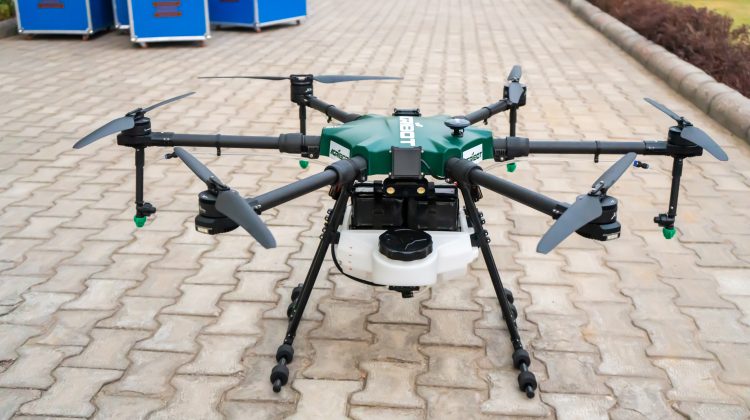
How Drones Are Used for Better Surveillance & Security?
Drones for security and surveillance, involving unmanned aerial vehicles, offer a unique information gathering and monitoring perspective. With technological advancements, security drones equipped with live video, infrared, and thermal sensors have become essential tools for law enforcement. This article explores the various types of drones used in surveillance, their key features, and their critical role in enhancing security measures across diverse scenarios. As we delve into the specifics, it becomes evident that the marriage of aerial surveillance drone technology and security transforms how we approach safety and vigilance.
Understanding Drone Surveillance
Drones for security and surveillance involve employing unmanned aerial vehicles to capture images and videos from afar or great heights. Its main aim is to gather information about specific targets like individuals, groups, or the environment. Drones are small, agile, and can navigate challenging terrains, making them excellent for surveying inaccessible objects. They offer a unique viewpoint, providing a first-person perspective not usually accessible to traditional photographers. Security drones with live video, infrared, and thermal sensors have become common in law enforcement.
Types Of Drones Used In Surveillance & Security
Various types of drones serve distinct purposes, each tailored to specific surveillance missions.
- Multi-rotor drones: These drones excel at hovering in a fixed position, making them adept at scrutinising detailed conditions of assets. However, their application is limited to smaller areas like mines, construction sites, and chemical plants.
- Fixed-wing drones: Designed for patrolling expansive regions such as coastlines, borders, and highways, fixed-wing drones boast extended operational periods without frequent recharging or refuelling.
- Hybrid fixed-wing drones: Bridging the gap between multi-rotor and fixed-wing models, hybrid VTOL drones prove invaluable in covering large areas with intricate environments. These drones combine multi-rotor drones’ vertical takeoff and landing capabilities with extended flight times, high cruise speeds, and impressive altitudes characteristic of fixed-wing drones.
Key Features of Surveillance Drones
Understanding these key features is essential to appreciate the capabilities these technological marvels bring to surveillance.
- Elevated Viewpoint: Surveillance drones can fly up to 100 metres in just a few seconds, providing security agents with a comprehensive view of the area.
- Quick Deployment: With a speed ranging from 20 to 40 km/h, drones can cover 350 to 500 metres in a minute.
- Remote Video Control: Surveillance drones allow remote video feeds to be directed limitlessly through a joystick or radio control.
- Data Collection Capability: With onboard sensors, drones collect substantial information.
Scenarios where Drones Enhance Security and Boost Safety
Drones are crucial in enhancing drone security surveillance and safety across various scenarios. These unmanned aerial vehicles, equipped with advanced capabilities, prove their effectiveness in several ways:
- Continuous Site Surveillance: Drones can conduct regular patrols to ensure ongoing surveillance of a location. This helps maintain constant vigilance over an area, providing a proactive security measure.
- Event Security: Drones secure public spaces during large-scale events like sporting events or concerts. Their aerial perspective allows for comprehensive monitoring and swift response to potential incidents, ensuring the safety of attendees.
- Rapid Incident Detection: Drones quickly detect incidents, allowing immediate response. This is crucial in preventing and addressing security breaches or hazards, especially in sensitive areas like nuclear or petrochemical plants.
- Intrusion Prevention: Drones are effective in preventing unwanted intrusion into secure sites. Their ability to cover large areas efficiently makes them instrumental in identifying and deterring potential threats.
- Monitoring Crowded Events: Drones can navigate crowded outdoor events, identifying suspicious behaviour and enhancing overall security. This capability is precious in ensuring public safety during gatherings or festivals.
- Swift Deployment to Remote Areas: Drones can be rapidly deployed to remote and inaccessible areas, quickly responding to situations that may be challenging for traditional security measures.
- Search and Rescue Operations: Drones assist in locating individuals who are either wanted or in danger, especially in hard-to-reach or inaccessible areas. This capability proves vital in search and rescue missions.
- Coordination Support: In crisis management situations, drones facilitate the coordination of deployed teams. This includes aiding public forces or emergency services by providing real-time aerial intelligence, thereby improving the efficiency of on-ground operations.
Also Know:
How does Drone Technology Benefit Surveillance and Security Services?
Drones are transforming the landscape of law enforcement and public safety, offering numerous advantages in the realm of security:
- Swift Response: In emergency situations, time is of the essence. Drones significantly enhance the speed of response. Unlike traditional manned patrols, surveillance drones can conduct perimeter checks 30 times faster, providing crucial feedback within minutes.
- Enhanced Visual Capabilities: Surveillance UAVs operate from elevated positions, providing a broad aerial perspective with no blind spots. Equipped with high-quality sensors and HD cameras, drones excel at detecting anomalies or events, even in low-light conditions and from considerable distances.
- Safety in Missions: Remote-controlled drones reduce risks for security personnel, as operators can remain at a safe distance. When faced with suspect apprehension or potential disasters, deploying a drone first allows for a preliminary assessment of the situation, minimising the exposure of human personnel to possible dangers.
- Cost Savings and Increased ROI: While the initial investment in drone technology may seem high, the long-term benefits far outweigh the upfront costs. The cost of deploying a security drone is around 20% of helicopter patrols and 40% of foot patrols, making them a cost-effective solution that provides a substantial return on investment.
The Role of Drones In Elevating Security Measures
Surveillance drone technology is in a constant state of advancement, and the prospects for their role in security services are up and coming. The role of drones in elevating security measures is as follows:
| Role | Security Measures |
| Smart Traffic Monitoring | Drones, armed with advanced cameras, oversee road activities, capturing evidence of unauthorised parking, emergency lane violations, and other traffic irregularities. Drones equipped with speakers aid in issuing warnings for smooth traffic management. |
| Risk Assessment and Response | Following events like rock falls or earthquakes, drones gather continuous 2D and 3D data to evaluate structural damage, plan evacuation routes, locate survivors, and assess erosion and flood risks. |
| Emergency Situational Analysis | Drones contribute to emergency response efforts by analysing building damage, planning evacuation routes, searching for survivors, and evaluating erosion and flood risks in the aftermath of events such as rock falls or earthquakes. |
| Ecological Monitoring | Drones play a crucial role in environmental surveillance, efficiently monitoring forest health and wildlife and mapping surface water. |
| Advanced Border Security | Drones are crucial for real-time surveillance, target acquisition, and tracking personnel movements, especially in challenging terrains. Thermal drones enhance surveillance capabilities, particularly for irregular activities. |
| Large-Scale Event Security | Drone surveillance is optimal for overseeing significant events, allowing rapid deployment and comprehensive monitoring to prevent illicit activities and safeguard event attendees. |
| Law Enforcement Support | Drones revolutionise law enforcement by capturing criminal activities, providing concrete evidence, and assisting in identifying individuals. Silent or stealthy drones enhance discreet surveillance for more effective policing. |
| Wildlife Conservation | Drones significantly protect endangered species by using thermal cameras and night vision to detect wildlife or individuals at night, facilitating anti-poaching efforts. |
| Efficient Search and Rescue | Equipped with high-resolution cameras and thermal imaging sensors, rescue drones efficiently cover large areas, providing real-time video feeds for search and rescue operations in remote or inaccessible areas. |
Challenges Surveillance Drone Face In Addressing Security and Safety Concerns
The versatility and operational efficiency of surveillance drone make them instrumental in overcoming various challenges, including:
- Observation of Large or Inaccessible Areas: Surveillance drones excel in observing expensive or difficult-to-reach locations, including areas that may be hazardous or inaccessible for humans.
- Perimeter Control and Site Inspection: They control defined parameters such as car parks, warehouses, and event venues. Drones also inspect the surroundings of monitored sites for enhanced security.
- Detection of Threats on Site: Surveillance drone are adept at identifying individuals or vehicles that may pose a security risk, enabling proactive threat detection.
- Real-time Information Transmission: These drones facilitate the real-time transmission of vital information, providing decision-makers with timely data to respond effectively to security challenges.
- Protection of People and Assets: Drones safeguard people and valuable assets, including high-value goods, dangerous materials, and production facilities.
Also Read:
Conclusion
In conclusion, surveillance drones, characterised by their elevated viewpoint, swift deployment, remote video control, and data collection capabilities, are indispensable in modern security operations. They contribute significantly to scenarios such as continuous site surveillance, event security, rapid incident detection, intrusion prevention, monitoring of crowded events, swift deployment to remote areas, search and rescue operations, and coordination support during crisis management. As we navigate the challenges and opportunities presented by surveillance drones, it is clear that they are not just tools. They are transformative agents shaping the future of security and safety.
Frequently Asked Questions
Q1: Do drones perform high-altitude surveillance?
A: Yes, the market offers numerous drones designed explicitly for high-altitude surveillance. The maximum altitude achievable for a drone is around 10 km (33,000 ft).
Q2: What's the typical duration a surveillance drone can remain airborne?
A: The airborne duration of surveillance drones varies from 45 minutes to over ten hours. The specific flight time depends on the drone’s type and the technology it employs.
Q3: What are some methods to detect a drone during night time?
A: Spotting a drone at night can be achieved by listening to propeller sounds, observing red and green navigation lights in the sky, or utilising radar equipment for detection. and autonomous flight capabilities, eliminating the need for qualified pilots.

